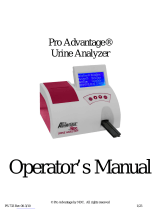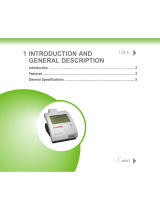
Roche Diagnostics
Urisys 1100 urine analyzer · Operator’s Manual (US) · Version 8
. Introduction
Manual version Software version Revision date Amendments
.x December Minor revision of text.
Operator ID, limited lock-out function, Device ID,
compatibility of barcode reader, ASTM protocol
.x May Updated barcode scanner material number, website
address and General Information section
.x September Remove references to Chemstrip
®
and Chemstrip
®
OB Test Strips, and test strip tray N; Removed reference
to Model SA A-U-S (Sino-American Switching
Adapter) power cable; Modified strip handling
instructions.
> = . - Chemstrip
®
and Chemstrip
®
removed from software
flow chart.
> = . - Test strip tray lifetime added.
Cleaning and maintenance section improved.
Paragraph Values obtained are implausible when
compared with those from visual evaluation revised in
section Error messages and troubleshooting.
Paragraph Control values fall outside the designated
ranges added in section Error messages and
troubleshooting.
The Urisys
®
Urine Analyzer (Cat. No. ) is a reflectance photometer designed to automatically read and
evaluate the results of Chemstrip
®
MD* Test Strips from Roche Diagnostics. It reads the strips under standard ized
conditions, saves the results to memory, and outputs them via its internal printer and/or serial interface.
Using the Urisys
®
Urine Analyzer eliminates factors known to affect visual evaluation of urine test strips, such as:
• Variable lighting conditions at the workplace
• Individual skill levels at matching test strip pad colors
• Different reaction times for the test strips
• Clerical errors
• Strong color of the urine sample
To perform a urinalysis test, simply dip the test strip in the urine sample, dab the long edge of the test strip lightly on
absorbent paper to remove excess urine, and place it in the test strip tray with the pads facing upward. Then press the
START button. Measurement is complete in seconds, and results are automatically printed.
The following symbol is used throughout this document.
WARNING/CAUTION: Indicates a potentially hazardous situation that, if not avoided,
!
could result in personal injury or damage to the instrument. This symbol is also used to
highlight situations that can compromise results.
Roche Diagnostics provides technical support. If you have any questions or need assistance, please
contact Roche Customer Support Center at ---.
* Hospitals may use Chemstrip
®
UA Urine Test Strips (Cat. No. ).























